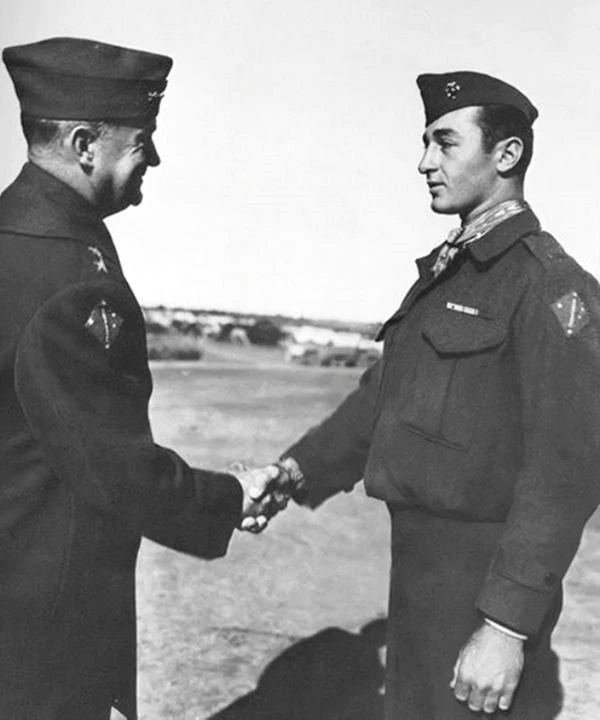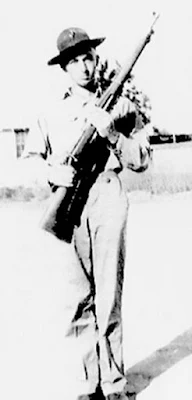 |
| 2nd Lt. Mitchell Paige wearing his Medal of Honor at the ceremony. |
Colonel Mitchell Paige (August 31, 1918 – November 15, 2003) was a recipient of the Medal of Honor from World War II. He received this, the highest military honor awarded by the United States of America, for his actions at the Battle of Guadalcanal in the Solomon Islands on October 26, 1942, where, after all of the other Marines in his platoon were killed or wounded, he operated four machine guns, single-handedly stopping an entire Japanese regiment.
Paige was born in Charleroi, Pennsylvania. His parents were Serb immigrants who arrived in the United States from the Military Frontier of Austria-Hungary, their last name being Pejić. His mother kept him and his brother in touch with their roots, reminding them of the Battle of Kosovo, but also told them to be proud Americans. His family later moved to the Camden Hills neighborhood of West Mifflin. He graduated from McKeesport High School before enlisting in the US Marines.
Paige enlisted in the Marine Corps on September 1, 1936 at Baltimore, Maryland and completed his boot camp training at Parris Island, South Carolina. In November 1936, he was transferred to Quantico, Virginia and later served as a gunner aboard the USS Wyoming. While aboard the Wyoming he took part in maneuvers via Panama to San Clemente Island off the coast of California. In February 1937, he was transferred to Mare Island Navy Yard for guard duty, and two months later was ordered to Cavite in the Philippine Islands. While on Cavite he became a member of the All-Navy-Marine baseball team, which gained prominence throughout the Islands and the Orient. He served in China from October 1938 to September 1939 and during his tour he guarded American property during the famous Tientsin flood. He left North China and returned to the U.S. in April 1940 for guard duty at the Brooklyn and Philadelphia Navy Yards. In September 1940 he rejoined the 5th Marines, at Quantico, and the following month participated in maneuvers at Guantanamo Bay, Cuba and Culebra, Puerto Rico.
In March 1941, he was transferred back to the States and ordered to New River, North Carolina, to help construct and prepare a new training base for Marines, which later became Camp Lejeune.
After the Japanese attack on Pearl Harbor, he was once more sent overseas with the 7th Marines and landed at Apia, British Samoa. From Samoa, the 7th Marines went to Guadalcanal, landing in September 1942. He earned the nation’s highest decoration for heroism, the Medal of Honor, during the campaign for Guadalcanal in October 1942, when he made a desperate lone stand against enemy Japanese after they had broken through the lines and killed or wounded all of the Marines in his machine gun section. Platoon Sergeant Paige fired his machine gun until it was destroyed, then moved from gun to gun, keeping up a withering fire until he finally received reinforcements. He later led a bayonet charge that drove the Japanese back and prevented a breakthrough in American lines.
While on Guadalcanal he was commissioned a second lieutenant in the field on December 19, 1942. He remained on the island until January 1943, when he went to Melbourne, Australia, with the 1st Marine Division. The Marine Corps’ World War II Commandant, Gen Alexander A. Vandegrift, presented the Medal of Honor to 2nd Lieutenant Paige there in the spring of 1943. In June 1943, he was promoted to first lieutenant.
In September 1943, 1st Lieutenant Paige left with the 1st Marine Division for New Guinea where they joined the 6th Army for the attack on Cape Gloucester, New Britain, on 26 December 1943. In May 1944, the Division left Cape Gloucester for a rest area in the Russell Islands, Pavuvu. In July 1944, 1st Lieutenant Paige was sent back to the States and assigned duty at Camp Lejeune, North Carolina. He was promoted to captain February 28, 1945. In June 1945, Capt. Paige became Tactical Training Officer at Camp Matthews, California, and the following September, was sent to the Marine Corps Recruit Depot as a recruit training officer. He was placed on inactive duty in May 1946, returning to active duty again in July 1950, and was assigned duty at Camp Pendleton, Oceanside, California.
He was later transferred to the Marine Corps Recruit Depot at San Diego, California, as Plans and Operations Officer of the 2d Recruit Training Battalion. At this time, he also went on a special assignment as Plans and Training Officer in charge of setting up a Platoon Leader’s Course training program for the Special Training Company. He was promoted to the rank of major on January 1, 1951.
In October 1951, Major Paige became Executive Officer of the 2nd Recruit Training Battalion, Marine Corps Recruit Depot San Diego, California, until October 1952, when he was transferred to the 4th Special Junior Course at Marine Corps Schools, Quantico. He attended school there until May 1953, then served as Division Recruiting Officer, 2nd Marine Division, Camp Lejeune, North Carolina, until February 1954.
Major Paige was next assigned to Sub-Unit #2, Headquarters Company, Headquarters Battalion, 3rd Marine Division, San Francisco, California, serving as Officer in Charge, Division Non-Commissioned Officers School until April 1955. During this period, he also served briefly as Assistant Officer in Charge of Sub-Unit #1.
From there he served as Battalion Executive Officer and later Commanding Officer of the 3rd Battalion, 7th Marines, 1st Marine Division at Camp Pendleton, from April 1955 until August 1955 when he reported to the 12th Marine Corps Reserve and Recruitment District to serve as Officer in Charge of Marine Corps Recruiting Station in San Francisco. He was promoted to lieutenant colonel in May 1957.
In August 1957, Lieutenant Colonel Paige was assigned duty as Inspector-Instructor, 7th Infantry Battalion, USMCR, at San Bruno, California, until August 1958, when he was detached to Headquarters Marine Corps, Washington, D.C.
In May 1959, he entered the U.S. Army Language School in Monterey, California, and remained there for nine months until he was ordered to the Marine Barracks, U.S. Naval Station, San Diego, California, to serve as Executive Officer until October 1959. He was placed on the Disability Retired List on 1 November 1959 and for being specially commended for performance of duty in actual combat he was promoted to colonel upon retirement.
Paige retired in 1959 with the rank of Colonel. In retirement, Paige wrote a book about his experiences titled A Marine Named Mitch (published in 1975). In his later years, he served to ferret out imposters wearing or selling the Medal of Honor.
On November 15, 2003, Paige died of congestive heart failure at his home in La Quinta, California at the age of 85. He was the last surviving Medal of Honor recipient of the Guadalcanal campaign. He was buried with full military honors at the Riverside National Cemetery in Riverside, California.
Through his life Paige received numerous awards both as a member of the military and as a civilian. In addition to receiving the Medal of Honor, he was also an Eagle Scout and had a G.I. Joe action figure designed in his likeness.
Among his numerous military decorations were: the Medal of Honor, the Purple Heart, the Presidential Unit Citation, the Good Conduct Medal, the China Service Medal, the American Defense Service Medal with Base clasp, the American Campaign Medal, the Asiatic-Pacific Campaign Medal with two bronze stars, the World War II Victory Medal, the National Defense Service Medal, the Korean Service Medal, the Marine Corps Reserve Ribbon, and the United Nations Service Medal.
Medal of Honor Citation
The President of the United States takes pride in presenting the MEDAL OF HONOR to
PLATOON SERGEANT MITCHELL PAIGE
UNITED STATES MARINE CORPS
for service as set forth in the following CITATION:
For extraordinary heroism and conspicuous gallantry in action above and beyond the call of duty while serving with the Second Battalion, Seventh Marines, First Marine Division, in combat against enemy Japanese forces in the Solomon Islands Area on October 26, 1942. When the enemy broke through the line directly in front of his position, Platoon Sergeant Paige, commanding a machine-gun section with fearless determination, continued to direct the fire of his gunners until all his men were either killed or wounded. Alone, against the deadly hail of Japanese shells, he manned his gun, and when it was destroyed, took over another, moving from gun to gun, never ceasing his withering fire against the advancing hordes until reinforcements finally arrived. Then, forming a new line, he dauntlessly and aggressively led a bayonet charge, driving the enemy back and preventing a breakthrough in our lines. His great personal valor and unyielding devotion to duty were in keeping with the highest traditions of the United States Naval Service.
/S/ FRANKLIN D. ROOSEVELT
In 1998, Paige served as the model for a G.I. Joe action figure. His was the Marine Corps figure in a series honoring Medal of Honor recipients from each branch of the U.S. military.
A Golden Palm Star on the Palm Springs Walk of Stars was dedicated to Paige in 1999, recognizing him as one of five Medal of Honor recipients from the Southern California desert area.
A museum at the Twentynine Palms Marine Corps base is dedicated to him.
Paige was presented with the Eagle Scout award by the Boy Scouts of America on March 24, 2003, which he had earned in 1936, his last year in high school, but had never received because he had left home to join the Marine Corps. (He is one of nine known Eagle Scouts who have received the Medal of Honor.) Paige is also a recipient of the Distinguished Eagle Scout Award from the Boy Scouts of America.
On May 2, 2006, the Desert Sands Unified School District honored Paige by naming its newest school the Colonel Mitchell Paige Middle School. The school opened in the Fall of 2006 in La Quinta, California.
The Eldred World War II Museum in Eldred, Pennsylvania, holds an exhibit dedicated to him, named “Mitchell Paige Hall.” Paige donated his entire collection of military memorabilia to the Eldred facility, including his Medal of Honor.
Nickname: Mitch
Born: August 31, 1918, Charleroi, Pennsylvania
Died: November 15, 2003 (aged 85), La Quinta, California
Place of burial: Riverside National Cemetery
Allegiance: United States of America
Service/branch: United States Marine Corps
Years of service: 1936–1959
Rank: Colonel
Unit: 2nd Battalion, 7th Marines
Battles/wars:
World War II
Battle of Guadalcanal
Cape Gloucester
Korean War
Awards:
Medal of Honor
Purple Heart
Presidential Unit Citation
 |
| 2nd Lt. Mitchell Paige accepts congratulations from Maj. Gen. A.A. Vandegrift of the 1st Marine Division, after receiving the Medal of Honor. |
 |
| 2nd Lt. Mitchell Paige accepts congratulations from Maj.Gen. A.A. Vandegrift of the 1st Marine Division, after receiving the Medal of Honor. |
 |
| Platoon Sergeant Mitchell Paige. Note Medal of Honor ribbon above ribbon bars. |
 |
| Pvt. Mitchell Paige. |
 |
| Sgt. Mitchell Page leads bayonet charge in final moments of battle on Guadalcanal. |
 |
| Mitchell Paige's grave site. |
 |
| The box for the G.I. Joe action figure designed in his likeness. |
 |
| The Mitchell Paige G.I. Joe figure. Note the small Medal of Honor with ribbon next to the figure’s left foot. |
 |
| The Mitchell Paige G.I. Joe figure with machine gun and wearing the small Medal of Honor with ribbon. |

















